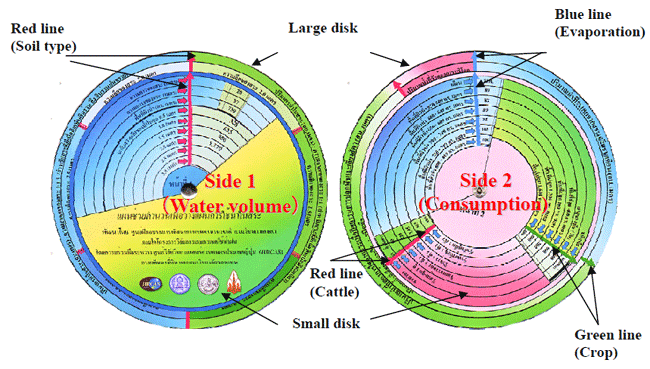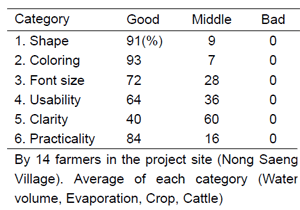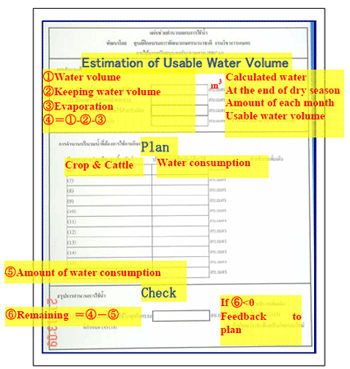Pond water use planning tool for integrated farming
Description
It is necessary for the carrying on of integrated farming that farmers plan water use for several months in advance. This study has developed a water use planning tool for farmers who have no prior experience of integrated farming. The tool is a disk which is made of paper. Through this, the farmers can instantly get information about their pond capacity, water loss during the dry season due to evaporation, water consumption of each agricultural product such as vegetables, cattle, etc..
The Thai government recommends integrated farming to small farmers using farm ponds in order to increase their income in Northeast Thailand. In fact, many ponds, with sizes of approximately 20 m×30 m have been constructed. However, most of the farmers use their ponds only for fish culture and not jointly for vegetables, fruits or cattle, etc. One of the reasons is the difficulty of water use planning for farmers who have no prior experience in integrated farming. Therefore, we tried to support the farmers’ water use planning and generate more utilization of integrated farming management by developing this water use planning tool for farmers.
Farmers can read their pond capacity and water consumption level from the disk tool, write down the values into the planning sheet, and evaluate the plan as follows.
Step 1: Estimation of usable water volume
- [Water resource] Use Side 1 of the disk. Select soil type (Clay, Sandy) of outer lane by matching the red line. Set ‘depth of pond’ in the 2nd lane, ‘length’ and ‘breadth’ in the 3rd and 4th lane, respectively. Read ‘pond area’ in the 5th lane, and read ‘water volume’ under 6th lane up to the depth of water.
- [Reserve water volume] Read the reserve water volume under the 6th lane up to the depth of water for fish culture.
- [Evaporation volume] Use Side 2 of the disk. Match blue line. Set 3rd lane to the month during the planning and read the evaporation under 4th lane up to the pond area respectively, and sum up all the values.
- [Usable water volume]=Ⅰ-Ⅱ-Ⅲ
Step 2: Water use planning
- Use Side 2 of the disk. Match green line. Set ‘crop’ in the 3rd lane, and read the water consumption under the 4th lane up to the cropping area. Match red line. Set ‘cattle’ in the 3rd lane, and read the water consumption under the 4th lane up to the stage of the cattle, and multiply the number of cattle. Sum up all the water consumption volume.
Step 3: Check the plan
- Remaining water volume=Ⅳ-Ⅴ
If the remaining water volume shows negative value, go back to Step 2 and start again.
- The results of the farmers’ evaluation of the tool are as follows. Clarity; Good: 40%, Middle: 60%, Practicality; Good: 84%, Middle: 16%, etc. (Table 1).
- Basic data shown on the disk are as follows: Shape of ponds, according to the standards of the Land Development Department (Thai); Evaporation, Khon Kaen Meteorological Station, Necessary Irrigation water volume for crops (Custard apple, Mango, Asparagus, Rice nursery, Maize, Tomato, Chili pepper, Eggplant, Coriander, Shallot, Long bean, Radish, Kale, Cauliflower, Cucumber, Water spinach), determined by FAO; Cattle drinking water requirements based on the JIRCAS experiment in the project site.
Figure, table
-
Fig. 1 Disk tool
(Match the line color of objective)
(Rotate small disk and read the value) -
Table 1 Evaluation by farmers
-
Fig. 2 Planning Sheet
- Affiliation
-
Japan International Research Center for Agricultural Sciences Crop Production and Environment Division
- Term of research
-
FY2007(FY2006~2010)
- Responsible researcher
-
SUKCHAN Uchada ( Agricultural Production Science Research and Development Center )
VERAKORNPHANICH Prasop ( International Training Center for Agricultural Development )
ODA Masato ( Crop Production and Environment Division )
CHONGPRADITNUN Praphasri ( Department of Agriculture Thailand )
CALDWELL John S. ( Crop Production and Environment Division )
SUPHANCHAIMAT Nongluck ( Khon Kaen University )
PHAOWPHAISAL Ittiphon ( Khon Kaen Animal Nutrition Research and Development Center )
Sukchan Somsak ( Land Development Department, Ministry of Agriculture and Cooperatives Department, Thailand )
- ほか
- Publication, etc.
-
U. Sukchan, J. S. Caldwell, M. Oda and M. Wilaikaew (2006): On-farm Testing of Technologies for Integrated Farming. JIRCAS W. R. No.47 129-134
- Japanese PDF
-
2007_seikajouhou_A4_ja_Part11.pdf636.73 KB



